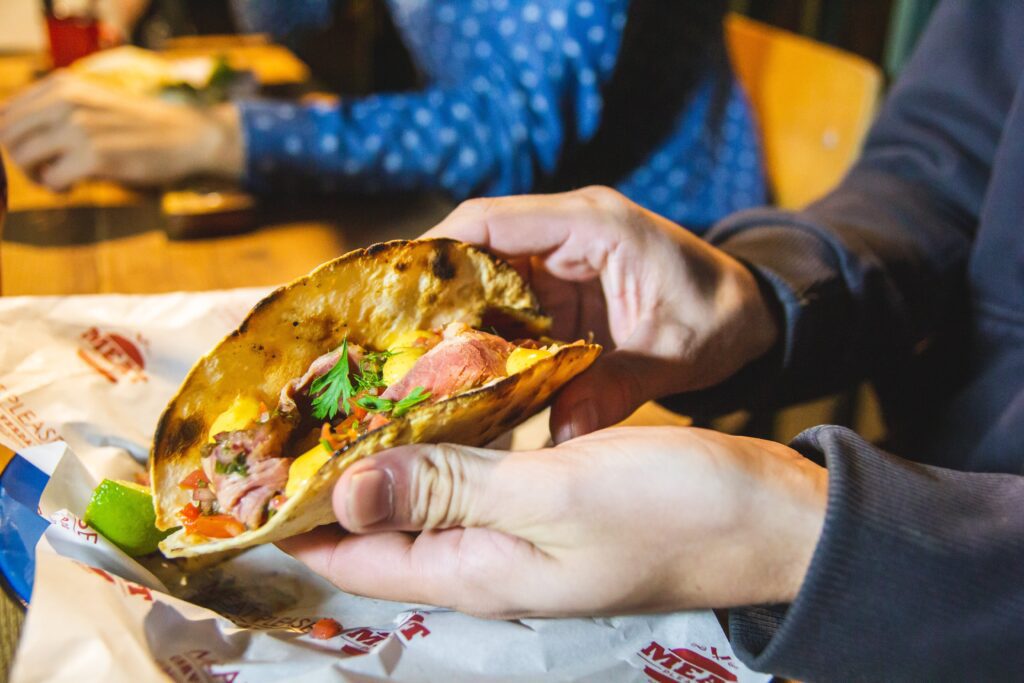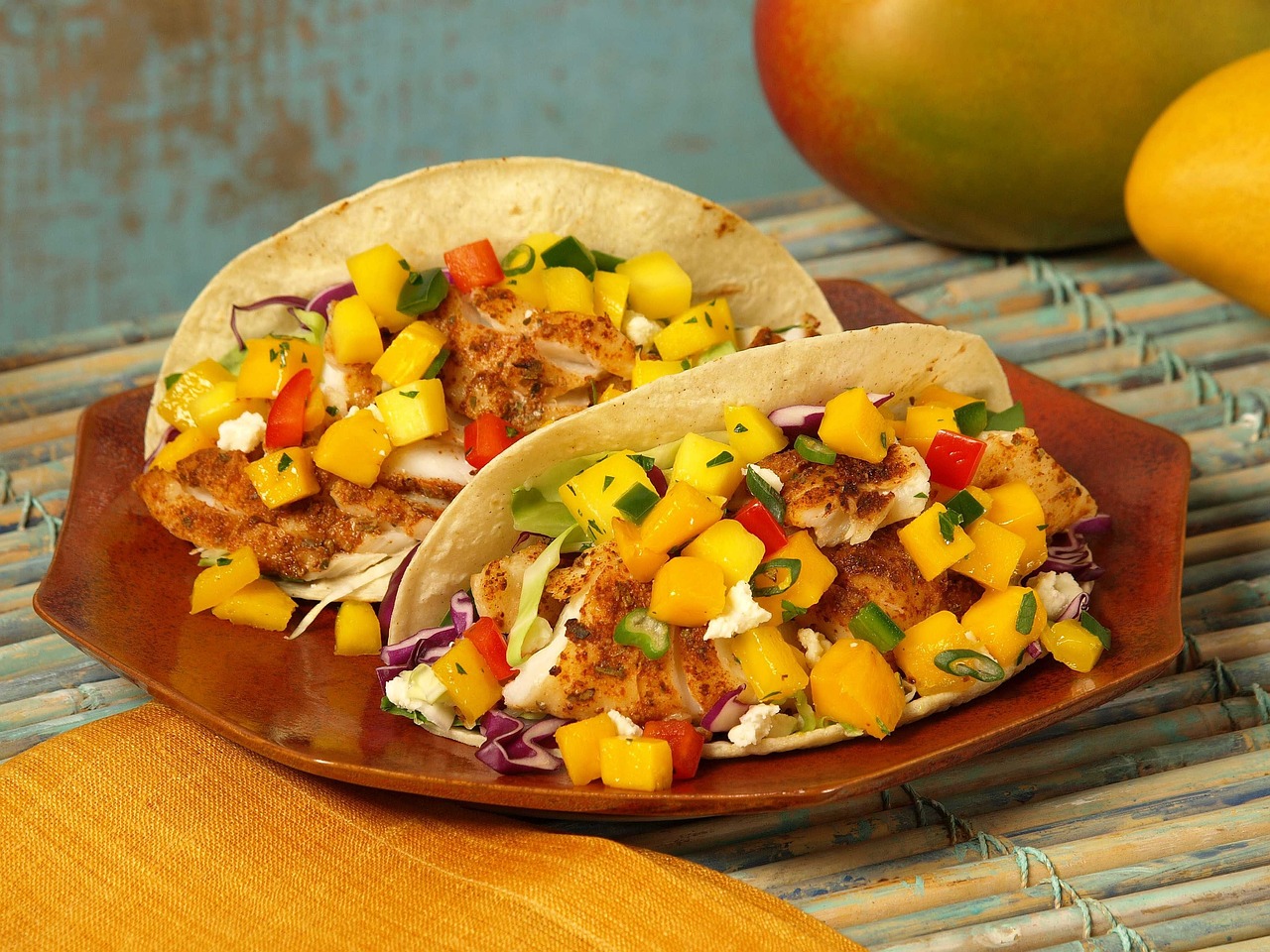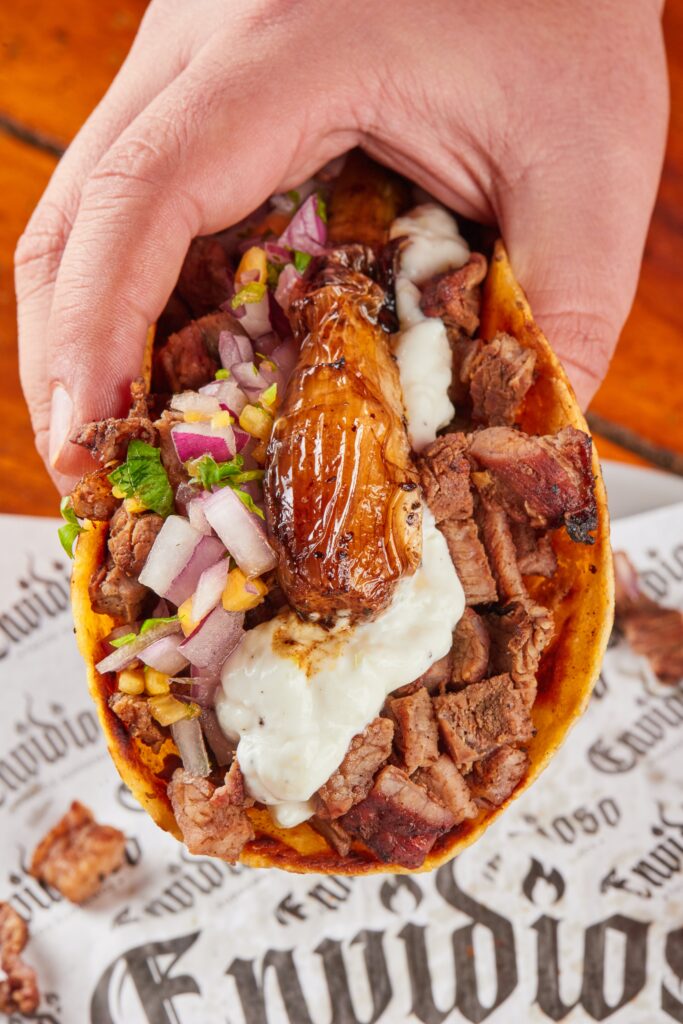What Does Taco Mean? Introduction
A taco is a traditional Mexican dish consisting of a folded or rolled tortilla filled with various ingredients. The tortilla is typically made from corn or wheat flour and is filled with a variety of fillings, such as seasoned meat (commonly beef, pork, or chicken), beans, cheese, lettuce, tomatoes, onions, and salsa. Tacos can be served soft or crispy, depending on how the tortilla is prepared. They are often eaten by hand and are a popular street food in Mexico and worldwide, enjoyed for their delicious flavors and versatility.
Tacos have a rich history and cultural significance in Mexican cuisine and are now enjoyed by people of various cultures and backgrounds. In this article, we will explore the origin and cultural significance of tacos and discuss the different interpretations of the taco definition.
The origin and cultural significance of tacos
Tacos have a long history in Mexican cuisine, dating back to the early 18th century. The word “taco” is derived from the Mexican Spanish word “taco,” which means “light lunch.” Originally, tacos were simple snacks or street food, consisting of a folded tortilla filled with various ingredients. They were commonly consumed by the working class in Mexico.
Over time, tacos evolved and became popular throughout Mexico, with various regions adding their own unique flavors and fillings. Tacos became an integral part of Mexican culture and were often associated with celebrations and festivities. They were also a symbol of unity, bringing people together to enjoy food and good company.
Different interpretations of the taco definition
The definition of a taco can vary depending on the region or cultural influences. In Mexico, tacos are typically made with soft corn tortillas and can be filled with a variety of ingredients such as meat, vegetables, salsa, and cheese. However, the fillings and toppings can vary greatly from region to region.
Outside of Mexico, tacos have been adapted to suit different culinary preferences. In the United States, for example, tacos are often made with flour tortillas and can be filled with ingredients such as ground beef, lettuce, cheese, and sour cream. Tex-Mex tacos are known for their bold flavors and generous portions.
In recent years, there has been a rise in fusion tacos, where different cuisines and flavors are incorporated into traditional taco recipes. These creative interpretations have opened up a world of possibilities for taco lovers, with options like Korean BBQ tacos or sushi tacos.
In conclusion, tacos have a rich history and cultural significance, originating from Mexico and evolving throughout the years to suit different tastes and preferences. Whether enjoyed in their classic form or with a modern twist, tacos continue to captivate food enthusiasts worldwide with their delicious flavors and endless possibilities.


Traditional Tacos
Traditional taco ingredients and preparation methods
Tacos are a beloved Mexican dish that has gained popularity worldwide. Traditional tacos are made with soft corn tortillas and filled with a variety of ingredients. The filling can include meat, vegetables, salsa, and cheese, depending on personal preferences. The tortillas are typically warmed before being filled and folded.
Regional variations of traditional tacos
In Mexico, tacos vary from region to region, each offering its unique flavors and fillings. Some popular variations include:
- Tacos al Pastor: These tacos are a specialty of Mexico City and feature marinated pork cooked on a spit. They are often topped with pineapple, cilantro, and onion.
- Tacos de Carnitas: Originating from Michoacán, these tacos are made with slow-cooked, tender pork. They are typically garnished with salsa, onion, and cilantro.
- Tacos de Barbacoa: Hailing from central Mexico, these tacos are made with slow-cooked, tender beef or lamb. They are often served with various toppings such as onion, cilantro, and salsa verde.
Outside of Mexico, tacos have been adapted to suit different culinary preferences. In the United States, for example, tacos are often made with flour tortillas and filled with ingredients such as ground beef, lettuce, cheese, and sour cream. Tex-Mex tacos are known for their bold flavors and generous portions.
In recent years, there has been a rise in fusion tacos, where different cuisines and flavors are incorporated into traditional taco recipes. These creative interpretations have opened up a world of possibilities for taco lovers, with options like Korean BBQ tacos or sushi tacos.
Traditional tacos are a delicious and versatile dish that has made its way into the hearts and stomachs of people worldwide. Whether enjoyed in their classic form or with a modern twist, they continue to delight and satisfy food enthusiasts everywhere.
Taco Evolution
How tacos have evolved over time
Tacos have come a long way since their humble beginnings in Mexico. While traditional tacos continue to be cherished, they have also undergone various adaptations to suit different tastes and culinary preferences.
In Mexico, traditional tacos are made with soft corn tortillas filled with a variety of ingredients such as meat, vegetables, salsa, and cheese. However, regional variations offer unique flavors and fillings. For example, Tacos al Pastor from Mexico City feature marinated pork with pineapple, cilantro, and onion, while Tacos de Carnitas from Michoacán are made with slow-cooked, tender pork garnished with salsa, onion, and cilantro. Tacos de Barbacoa from central Mexico are made with slow-cooked, tender beef or lamb and served with onion, cilantro, and salsa verde.
Fusion tacos and their unique flavors
Outside of Mexico, tacos have been adapted to cater to different tastes. In the United States, flour tortillas are commonly used, and fillings may include ground beef, lettuce, cheese, and sour cream. Tex-Mex tacos are known for their bold flavors and generous portions.
Recently, fusion tacos have gained popularity, incorporating different cuisines and flavors into traditional taco recipes. This creative approach has resulted in unique options like Korean BBQ tacos or sushi tacos. These fusion tacos provide a delightful twist to the traditional dish and have captured the attention of adventurous food enthusiasts.
Tacos have evolved from their traditional roots to encompass a wide array of flavors and preparations. Whether enjoyed in their classic form or with a modern twist, tacos continue to be a beloved and versatile dish that brings happiness and satisfaction to people around the world.


Modern Taco Varieties
Popular modern taco styles and fillings
Tacos have undergone a significant evolution over time, adapting to different tastes and culinary preferences. While traditional tacos are still cherished, there are now various modern taco styles that have gained popularity. These modern varieties offer unique flavors and fillings that cater to a diverse range of preferences. Some popular modern taco styles include:
- Baja-style tacos: Inspired by the flavors of Southern California, Baja-style tacos typically feature battered and fried fish or shrimp, topped with cabbage slaw, salsa, and a creamy sauce. This style of taco offers a refreshing and tangy taste.
- Street tacos: Street tacos have become increasingly popular, providing a quick and convenient way to enjoy tacos on the go. They are typically small in size and filled with grilled meats like carne asada or al pastor, topped with onions, cilantro, and a squeeze of lime.
- Vegetarian and vegan tacos: With the rise of plant-based diets, vegetarian and vegan tacos have become more prevalent. These tacos often feature ingredients such as grilled vegetables, beans, tofu, or plant-based meat substitutes, topped with fresh salsas and creamy vegan sauces.
Creative and innovative taco creations
In addition to the popular modern taco styles, there has been a surge in creative and innovative taco creations. Chefs and food enthusiasts have embraced the versatility of tacos and have incorporated different cuisines and flavors to create unique and unexpected combinations. Some examples of these creative taco creations include:
- Korean BBQ tacos: These tacos combine the bold flavors of Korean barbecue with the traditional taco format. They often feature marinated and grilled meats such as bulgogi or spicy pork, along with kimchi and other Korean-inspired condiments.
- Sushi tacos: A fusion of Japanese and Mexican cuisines, sushi tacos bring together the concept of sushi rolls and tacos. These tacos are typically made with a crispy nori shell filled with sushi rice, sashimi-grade fish, avocado, and other sushi fillings, topped with soy sauce and wasabi.
- Dessert tacos: Tacos are not limited to savory fillings; there are also creative dessert versions available. Dessert tacos may feature sweet fillings such as Nutella, fruit compote, whipped cream, or ice cream, served in a crispy taco shell or a sweet tortilla.
As tacos continue to evolve and embrace different flavors and preparations, individuals can enjoy a wide range of options that suit their preferences and adventurous spirit. From traditional tacos to modern variations and creative creations, the taco has truly become a versatile and beloved dish that delights food lovers around the world.
Taco Terminology
Understanding common taco terms and jargon
Tacos can sometimes come with a unique set of terms and jargon. Here are some common taco terminologies:
- Al Pastor: A taco filling made from marinated pork, typically cooked on a vertical spit called a trompo.
- Burrito: A larger tortilla filled with various ingredients, similar to a taco but often rolled up and wrapped in foil.
- Carnitas: Slow-cooked, tender, seasoned pork usually served in small pieces or shredded.
- Chorizo: A spicy Mexican sausage made from ground pork and seasoned with various spices, typically used as a taco filling.
- Enchilada: A tortilla filled with ingredients such as meat, cheese, or beans, rolled up, and topped with sauce.
- Fajitas: Grilled meat (usually beef or chicken) served on a tortilla with grilled peppers and onions.
Exploring the language of tacos
Tacos have their own language, and understanding the different terms can enhance your taco-eating experience. Here are a few examples:
| Term | Definition |
|---|---|
| Asada | Grilled or roasted meat, often referring to beef or steak. |
| Cilantro | A herb with a distinct flavor often used as a garnish or in salsas. |
| Pico de Gallo | A fresh salsa made from chopped tomatoes, onions, jalapenos, cilantro, and lime juice. |
| Salsa Verde | A green salsa made from tomatillos, jalapenos, cilantro, and other ingredients. |
| Tortilla | A thin, flatbread made from corn or flour, used to wrap the taco fillings. |
Understanding these common taco terms and jargon can help you navigate menus and have a better appreciation for the versatility and deliciousness of tacos.
Taco Etiquette
Proper etiquette and manners when enjoying tacos
When it comes to enjoying tacos, there are some unwritten rules and etiquette to keep in mind. Here are a few guidelines to follow:
- Use your hands: Tacos are meant to be eaten with your hands, so don’t be shy about getting a little messy. Avoid using a knife and fork unless absolutely necessary.
- Hold it properly: When picking up a taco, hold it from the bottom to prevent any fillings from falling out. Use your thumb and fingers to secure the taco.
- Don’t overload: While it’s tempting to load up on all the toppings and fillings, be mindful not to overstuff your taco. Overfilling can make it difficult to eat and can lead to a messy eating experience.
- Take small bites: Tacos are best enjoyed in smaller, manageable bites. Taking big bites can result in fillings spilling out or the taco falling apart.
- Try different salsas: Many taco vendors offer a variety of salsas to accompany your taco. Feel free to sample different ones to find your preferred level of spiciness and flavor.
- Don’t double-dip: If you’re enjoying your taco with a side of salsa or guacamole, be courteous and avoid double-dipping. Use a clean chip or spoon each time you want to add some more.
Unwritten rules of taco consumption
In addition to proper etiquette, there are some unwritten rules that taco lovers often follow:
| Rule | Description |
|---|---|
| One taco at a time | It is generally frowned upon to start eating multiple tacos at once. Finish one before moving on to the next. |
| No sharing | Unless specifically offered, it’s best to refrain from sharing your taco with someone else. Tacos are often enjoyed individually. |
| Savor the flavors | Take the time to savor the different flavors and textures of your taco. Enjoy each bite and appreciate the craftsmanship that went into creating it. |
| Respect the taco | Handle your taco with care and avoid squishing or smashing it. Treat it as a culinary masterpiece. |
| Enjoy the experience | Tacos are more than just a meal – they’re an experience. Take the time to enjoy the atmosphere, the company you’re with, and the delicious flavors. |
By following these guidelines and unwritten rules, you can fully appreciate the taco-eating experience and show respect for this beloved culinary delight. So, next time you indulge in a taco, remember to eat it with your hands, savor the flavors, and enjoy every delicious bite.
Taco Culture
Exploring the influence of tacos in pop culture
Tacos have become more than just a delicious food item; they have made their way into pop culture in various forms. From movies and TV shows to music and fashion, tacos have become a symbol of fun, flavor, and diversity.
In movies and TV shows, tacos are often used to depict casual and enjoyable dining experiences. They are often shown as a go-to food for characters when they want something quick, tasty, and satisfying. Tacos have become an iconic representation of laid-back dining and are often associated with gatherings of friends and family.
Tacos have also made appearances in music, with references to tacos being made in songs across different genres. These mentions showcase the love and appreciation people have for tacos and the role they play in their lives. Artists use tacos as metaphors for enjoyment, celebration, and the good times.
Taco-inspired fashion has also gained popularity, with clothing and accessories featuring taco prints, patterns, and slogans. T-shirts, socks, hats, and even jewelry celebrate the taco culture and allow people to show off their love for this beloved food.
Taco festivals, competitions, and events
To celebrate the rich taco culture, various festivals, competitions, and events dedicated to tacos have emerged around the world. These events bring together taco enthusiasts, food vendors, and chefs to showcase their skills and delight attendees with a wide array of taco creations.
Taco festivals offer a unique opportunity for people to taste different types of tacos, ranging from traditional to fusion and experimental varieties. These events often include live music, entertainment, and activities for all ages, creating a vibrant and festive atmosphere.
Competitions such as taco eating contests challenge participants to consume as many tacos as they can within a given time frame. These thrilling events attract both participants and spectators who enjoy the excitement and the spectacle of watching people devour tacos at lightning speed.
Whether you’re a taco aficionado or simply enjoy indulging in this tasty treat, participating in taco festivals, competitions, and events can be a memorable experience. It allows you to explore new flavors, appreciate the artistry behind taco creation, and connect with fellow taco lovers.
The influence of tacos in pop culture and the rise of taco-related events highlight the widespread love and appreciation for this versatile and delicious dish. Through their portrayal in movies, music, fashion, and the celebration of taco-inspired events, tacos have become an integral part of our cultural landscape.
Health and Nutrition
The nutritional value of tacos
Tacos may be known for their delicious taste, but they also offer some nutritional value. While the exact nutrition content can vary depending on the toppings and fillings used, tacos can provide a balanced mix of carbohydrates, protein, and essential nutrients.
Here are some key nutrients found in tacos:
- Protein: Tacos can be filled with various protein sources such as grilled chicken, lean beef, or beans. Protein is essential for muscle repair and growth and helps keep you feeling full and satisfied.
- Fiber: If you opt for whole grain tortillas or include beans as a filling, tacos can be a good source of dietary fiber. Fiber is crucial for a healthy digestive system and can help regulate blood sugar levels.
- Vitamins and minerals: Depending on the ingredients used, tacos can provide essential vitamins and minerals like vitamin C, vitamin A, iron, and calcium. These nutrients are important for various bodily functions and overall health.
Tips for creating healthier taco options
While tacos can be a part of a balanced diet, there are ways to make them even healthier. Here are some tips to consider:
- Choose whole grain tortillas: Whole grain tortillas are higher in fiber and offer more nutrients compared to white flour tortillas. Look for options that include whole grains like whole wheat or corn.
- Load up on vegetables: Include a variety of colorful vegetables like lettuce, tomatoes, onions, and peppers in your tacos. Vegetables add flavor, texture, and additional vitamins and minerals.
- Opt for lean protein: When selecting your taco filling, choose lean protein sources like grilled chicken, fish, or tofu. These options are lower in saturated fats and can be a healthier choice compared to fatty meats.
- Watch your portion sizes: Pay attention to portion sizes, especially if you’re trying to manage your calorie intake. Avoid overfilling tacos and stick to a reasonable serving size.
By making smart choices when it comes to ingredients and portion sizes, you can enjoy tacos while still maintaining a healthy lifestyle. Incorporate a variety of nutritious fillings and toppings, and tacos can be a satisfying and nourishing meal option.


Conclusion
Reflecting on the diverse and delicious world of tacos
Tacos are a versatile and beloved food that is enjoyed by people all over the world. From traditional Mexican street tacos to fusion creations, there is no shortage of variety when it comes to this popular dish. Tacos can be customized with a wide range of fillings, toppings, and sauces, allowing for endless flavor combinations.
Personal experiences and recommendations for taco enthusiasts
As taco enthusiasts, we have tried numerous types of tacos and have our personal favorites. Some of the most memorable taco experiences include enjoying fresh seafood tacos by the beach, savoring spicy and flavorful carnitas tacos from a local food truck, and indulging in vegetarian-friendly tacos filled with grilled vegetables and creamy guacamole.
For those who are new to the world of tacos or looking to expand their taco horizons, we recommend exploring different regional variations such as Baja-style fish tacos, al pastor tacos with marinated pork, or Korean-inspired tacos with bulgogi beef.
Remember, tacos are meant to be enjoyed and celebrated. Whether you prefer traditional or creative interpretations, the key is to savor each bite and appreciate the craftsmanship and flavors that make tacos such a beloved culinary delight. So go ahead, explore, taste, and experience the wonderful world of tacos.
Frequently Asked Questions – What Does Taco Mean: Exploring the Taco Definition
Q: What does the word “taco” mean?
A: The word “taco” typically refers to a traditional Mexican dish consisting of a tortilla (usually made of corn or wheat) that is folded or rolled and filled with a variety of ingredients such as meat, vegetables, cheese, and salsa.
Q: Where does the term “taco” come from?
A: The word “taco” is derived from the Mexican Spanish word “taco,” which originally referred to a small piece of paper or cloth used to plug a gunshot wound. Over time, this term was then applied to the rolled-up tortilla, resembling the shape once used to plug wounds.
Q: Are tacos only popular in Mexico?
A: While tacos originated in Mexico, they have gained immense popularity worldwide. Tacos can now be found in various forms and flavors throughout the United States, Canada, Europe, and many other countries. Tacos have become a beloved part of global cuisine.
Q: What are the different types of tacos?
A: Tacos come in a wide variety of types, each with unique flavors and ingredients. Some popular types include the street-style taco (smaller and simpler), the traditional taco (folded or rolled tortilla with various fillings), the hard-shell taco (crispy shell), and the soft-shell taco (flexible tortilla). There are also vegetarian and vegan taco options available.
Q: Are there any specific rules for eating tacos?
A: While there are no strict rules, there are some tips to enjoy tacos to the fullest. Firstly, avoid overfilling the taco to prevent it from falling apart. Secondly, it is customary to use your hands to eat tacos, but you can also use utensils if you prefer. Finally, feel free to get creative with toppings and salsas to personalize your taco experience.
Q: Can you provide some examples of popular taco fillings?
A: There is a wide range of delicious fillings for tacos. Some popular options include seasoned grilled meat such as carne asada, al pastor (marinated pork), or pollo asado (grilled chicken). Vegetarians might enjoy fillings like grilled veggies, beans, or cheese. Toppings like chopped onions, cilantro, salsa, guacamole, and lime juice are also commonly used.
Q: Are there any cultural or historical significances associated with tacos?
A: Tacos have a long history deeply rooted in Mexican culinary tradition. They are considered a staple food in Mexican cuisine and have been enjoyed for centuries. Tacos are often associated with street food culture, representing the vibrancy and flavors of Mexican street markets.
Q: Are there any health benefits of eating tacos?
A: The healthiness of tacos depends on the ingredients used and the cooking methods. Tacos can be a nutritious meal if filled with lean proteins, fresh vegetables, and whole-grain tortillas. However, when ingredients like fried meats, excessive cheese, and unhealthy toppings are used, they can be higher in calories and less healthy.
Q: Can tacos be customized to suit dietary restrictions?
A: Absolutely! Tacos offer great flexibility, making them versatile for various dietary restrictions. They can be adapted to be vegetarian, vegan, gluten-free, or dairy-free by using different fillings, alternative tortillas, and omitting or substituting ingredients as needed. Many restaurants and food establishments offer customizable options.
Q: Can tacos be eaten for every meal?
A: While tacos are delicious for any meal, whether it’s breakfast, lunch, or dinner, they are also commonly enjoyed as street food and snacks. The flexibility of tacos allows them to be enjoyed at any time of the day, depending on personal preferences and culinary creativity.
Q: How can I make tacos at home?
A: Making tacos at home is quite simple. Start by selecting your preferred tortilla and filling, such as grilled meat or vegetables. Heat the tortillas, fill them with the desired ingredients, and top them with your favorite toppings and salsas. There are countless recipes and variations available online or in cookbooks to suit your taste buds. Enjoy the process of creating your own homemade tacos!



Hey there! If you’re a fan of authentic Mexican cuisine, you’re in for a treat with Humberto Cruz at pointcafeny.com. They take immense pride in serving their customers with home-cooked, genuine Mexican dishes crafted with the finest ingredients. From flavorful salsa to mouthwatering tamales and enchiladas, they offer an experience that brings the taste of family food from back home right to your table. Don’t forget to check out their tempting Daily Specials for a delightful culinary adventure!
